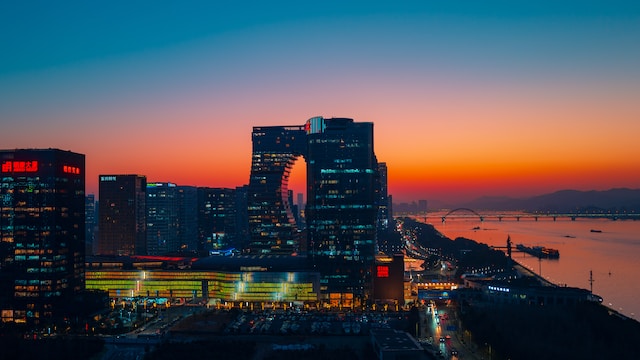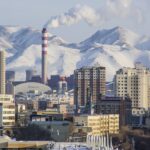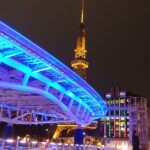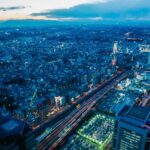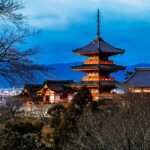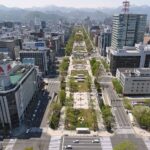The Yangtze River Delta city of Hangzhou has good access to public transportation. In Hangzhou, there are buses, metros, taxis, and ferries available for use by the public. One of China’s most comprehensive public transit networks is the 13-line Hangzhou Metro, which serves the city. There are a number of public buses that connect the major hubs of the city, as well as private buses that travel to farther-flung areas. Taxis are another option and a terrific way to see the city. The West Lake and Qiantang River may both be crossed by ferries. In Hangzhou, all modes of transportation are inexpensive and effective.
Metro system in Hangzhou – Basic information
The 13 lines and 270 stations of the modern and effective Hangzhou Metro system serve Hangzhou. The lines cover a large area of the city, giving easy access to many of the main attractions and districts of the city. The metro system is clean, safe, and reliable, making it a popular choice for commuters and tourists alike. The fare system is based on the distance traveled, and tickets can be bought using prepaid cards, cash, or mobile payment systems. Additionally, discounts are available for students and senior citizens. The metro system is also integrated with the bus and ferry services, providing an integrated public transport system for the city.
The lines of the Hangzhou subway system
The Line 1 is an arc-shaped rapid transit line that travels through downtown Hangzhou on its way from Xianghu station in the western Xiaoshan District to Xiaoshan International Airport in the eastern Xiaoshan District. It is the city’s oldest metro station. There are 33 stops along the 52 km-long line.
A north-south rapid transit line in Hangzhou, Line 2 of the metro, links the city center with the Xiaoshan and Yuhang districts. After six years of development, the first phase of the line, which runs between Qianjiang Road and Chaoyang stations, officially opened for service in 2014.
Line 3 is 57.5 kilometers long. It will travel through downtown Hangzhou and offer transfers to numerous other lines in the system as it travels from Wushanqiancun station in Yuhang District to Xingqiao station in Linping District in the east. The 6-car Type AH rolling stock is used on the line and was created specifically for Hangzhou.
Line 4 began operating in 2015. The line connects Hangzhou East Railway Station, Qianjiang New City, and Binjiang District and runs northeast to southwest. The Qianjiang Road to Shuicheng Bridge section of the line follows the north bank of the Qiantang River. The length of Line 4’s second phase is 26 kilometers.
Line 5 is shown in cyan.
The Hangzhou Metro’s Line 6 is a subway line that is only partially operational. The line originates at Shuangpu (in Xihu District) and West Guihua Road (in Fuyang District), merges at the China Academy of Art station at Xiangshan Campus, and then continues along the south bank of the Qiantang River before turning northwest and coming to an end at Goujulong. It links the Binjiang District, the Hangzhou Olympic Sports Expo Center, the Qianjiang Century City, and the Hangzhou East Railway Station to the Fuyang District. The length of the line is 58 kilometers. Blue is the hue of the line. The stations from Shuangpu to Xiaming Street will be combined with Line 12 in future planning.
Line 7 traverse through downtown Hangzhou and offer transfers to numerous other lines in the system as it travels 47.48 km in length from Wushan Square station in Shangcheng District to Jiangdong’er Road station in Qiantang District in the east. Line 8 is a 17.17 km line and travels from South Wenhai Road station to Xinwan Road station in Qiantang District in a west-to-east direction. Line 9 is 29.45 km long and runs in a north–south direction between Guanyintang and Long´an. The line is colored brown on system maps. Line 10 is from Huanglong Sports Center station in Xihu District and Yisheng Road station in Yuhang District up in the north, the line’s length is 14.7 kilometers, traveling through west Hangzhou. Line 16 is an east-west line that connects Jiuzhou Street in Lin’an District to Lvting Road in Yuhang District. There are 35.12 kilometers in total. Line 19 began service on September 2022.
Map of Hangzhou Metro 2023 – Free Download in PDF

Click and download the map of Hangzhou’s underground system for 2023
Anyone looking to travel to Hangzhou can check out the Hangzhou Metro Map 2023. It is readily available to everyone as a free PDF download. Each metro line and its corresponding stops are shown on the map, along with interesting places to visit and other helpful details. Before visiting Hangzhou, it is an excellent method to become familiar with the city and its transportation system. It is a fantastic resource for anyone who is considering traveling there due to its clear layout and comprehensive information.
Public transport tickets in Hangzhou – Best types for travelers & actual prices
The Hangzhou transit Smart Card (HTSC) is the most popular method of purchasing tickets for public transit in Hangzhou. All of the city’s public transit can be utilized with this prepaid card. Any ticket office, kiosk, or convenience store in Hangzhou allows you to top it off. The card itself costs 50 yuan, and the smallest top-up is 20 yuan. For frequent travelers, the HTSC card offers the most cost-effective booking alternative, with savings of up to 25%.
There are numerous ticketing choices available for those who intend to use Hangzhou’s public transit for a brief length of time. Any ticket window or kiosk will sell single tickets. The price of the ticket varies depending on how far you travel. Additionally, visitors can purchase one-day, three-day, and seven-day passes. These passes, which may be purchased at any kiosk, provide limitless travel for the duration of the pass.
The three-day pass is the best ticket choice for visitors who only intend to stay in Hangzhou for three days. The three-day pass can be purchased at any ticket counter or kiosk and offers unlimited travel for three consecutive days. The three-day pass is priced at 70 yuan.
Timetables & Schedules of Hangzhou Metro system
Every day, service on the Hangzhou Metro begins at 6 am and continues until 11 night. The frequency of train arrivals at stations ranges anywhere from four minutes to fifteen minutes, depending on the line and the time of day. Each route is serviced by a mix of 6-car and 8-car trains, with the majority of the service being provided by 8-car trains during peak hours.
What Are Other Options For Public Transportation In Hangzhou?
In addition to the metro, a number of other modes of public transit are available in Hangzhou. Buses, taxis, ferry services, and even car and bike sharing are included in this category of transportation options.
how does the public bus transportation work in Hangzhou
In the city of Hangzhou, China, taking the public bus is an essential component of day-to-day living. This bustling metropolis boasts an extensive public transit system that includes over 1,400 bus routes, making it easy and quick for both residents and visitors to get around the city.
At each and every bus stop, you’ll find vending machines selling bus tickets, and you can pay for them with either cash or a transit card. You can use the official Hangzhou bus app or the official website to locate the most efficient route for your trip. These two offer up-to-date information on routes, schedules, and fares for their respective services.
The 5, 7, 11, 17, and 26 bus lines are the ones that are used the most frequently in Hangzhou. The downtown area is connected to the airport, the train station, and other popular destinations by means of these buses, which travel from the city center to the suburbs and back again. In addition, there are a number of express routes that can reduce the amount of time spent traveling.
The majority of Hangzhou’s public transportation buses are not only clean and pleasant, but also air-conditioned. The fare is often between 1 and 2 yuan, and it can be paid for using either cash or a transit card. In addition, there is a flat cost for some routes, such as the one that goes to the airport as well as the one that goes to the train station.
How do the public TRAINS work in Hangzhou?
The railroad links from Hangzhou to Shanghai, Nanjing, and Suzhou are among the most essential in the country. It takes approximately an hour and a half to go to Shanghai, while Nanjing and Suzhou are both located a little bit more than two hours away. Because they are convenient, dependable, and reasonably priced, traveling by rail is an excellent choice for tourists.
Additionally, Hangzhou has excellent connections to the provinces and cities that are located in its vicinity. There are multiple high-speed rail lines that connect Hangzhou to other major cities in the area, including as Wuhan, Beijing, Guangzhou, and Xi’an. One of these lines is called the Hangzhou High-Speed Rail. These lines are especially helpful for tourists who wish to go throughout the region but do not have the time to board a flight that goes directly there.
How To Get From Hangzhou Xiaoshan International Airport (HRB) To The City Center With Public Transport?
The Hangzhou Xiaoshan International Airport can be found roughly 27 kilometers to the east of the central business district of Hangzhou. Utilizing the various forms of public transit is the most efficient means of reaching the city core.
Taking the airport shuttle bus is the choice that offers the most advantages in terms of convenience and economy. The scenic area of West Lake and the Hangzhou Railway Station are the two destinations that may be reached by using the shuttle bus that leaves from the airport and travels across the city. The ride lasts for roughly forty minutes, and the cost of a ticket is approximately fifteen yuan for each passenger.
Taking a taxi is the second alternative available to you. Taxis are easily accessible outside of the airport building, and the ride takes around 40 minutes and costs about 100 yuan in total.
If you would rather use the train, the Hangzhou East Railway Station is the station that is located the closest to the airport; its distance from the airport is roughly 20 kilometers. The ride lasts for approximately forty minutes, and the cost of a ticket is approximately twenty-five yuan for each passenger.
In conclusion, a bus service is also offered to passengers departing from the airport. A trip to the city center via bus from the airport takes roughly one hour and costs approximately 10 yuan per person. Buses depart from the airport.
how to spend 3 days in Hangzhou?
If you want to have an experience that is truly one of a kind in the stunning city of Hangzhou, then you should plan on staying there for at least three days to take advantage of everything the city has to offer. The city of Hangzhou is well-known for its intriguing history, mouthwatering regional food, and lively nightlife. This three-day itinerary is designed to help you make the most of your stay in this bustling city, regardless of whether this is your first time here or you are a seasoned traveler.
Your first day in Hangzhou should be spent beginning your journey with a visit to West Lake. This UNESCO World Heritage Site is located in the center of Hangzhou, and it is a stunning location in which to take in the scenery and investigate the numerous pagodas and temples that are dispersed around the lake. After that, take some time to unwind by going on a boat trip around the lake. The local boatmen will fill you in on all of the history and myths associated with the region.
Visit the Lingyin Temple, which is both one of the largest and oldest Buddhist temples in China, on the second day of your trip. It is an excellent destination to learn about Buddhism and Chinese culture, in addition to being famous for the stunning architecture and statues that can be found there. Following your visit to the temple, take a leisurely stroll around the neighboring tea plantations and reward yourself with a cup of the renowned Longjing tea produced in the city.
On the third day, you should check out some of the nightlife that Hangzhou has to offer. There is a diverse selection of restaurants and bars from which to pick. Inquire with the concierge of your hotel for recommendations from the community, or head to one of the many popular eateries located along Hefang Street to sample some delectable Chinese street food. Following supper, make your way to one of the city’s well-known bars or nightclubs. Visit one of the numerous karaoke bars in the area and sing along to some of your favorite songs for a one-of-a-kind experience.
What other metro systems are nearby in Hangzhou?
China’s Zhejiang Province is home to the city of Hangzhou, which may be found there. Hangzhou is a big metropolitan area, hence it has a variety of different metro systems in the surrounding area. The Ningbo Metro, the Shaoxing Metro, the Wenzhou Metro, and the Huzhou Metro are some examples of these. All of these systems make it possible to reach Hangzhou quickly and easily, as they are all located within a few hours’ drive of the city.
CHECK OUT THIS AMAZING HANGZHOU PUBLIC TRANSPORTATION VIDEO TOUR GUIDE
Summary of our tour guide for Hangzhou
Since I’ve been living here in Hangzhou, China, I’ve had plenty of opportunities to utilize the city’s public transit system. In my experience in Hangzhou, the city’s public transportation system is remarkable in both its effectiveness and its dependability. The buses and metro lines are very well structured, and as a result, they make traveling to any part of the city both rapid and simple. In addition to this, the city is equipped with a wide network of bike-sharing stations, which provides even more possibilities for public transit. In addition, the city has created a number of bus lanes exclusively for use by buses, which has made it simpler to travel throughout the city without becoming bogged down in traffic. The prices of rides on Hangzhou’s public transit are also quite inexpensive, making this mode of transportation not only affordable but also a convenient way to go around the city.
Top 5 FAQs and answers about Hangzhou public transport!
Could you tell me about the many kinds of public transportation that are available to you in Hangzhou?
- The city of Hangzhou provides its residents with a wide variety of options for public transportation, including but not limited to buses, taxis, metro trains, and ferries. Because their routes cover the entirety of the city, buses are the most common form of public transportation in the city. This makes it simple to board a bus from any location in the city. Taxis are yet another popular option inside the city of Hangzhou due to the fact that they are an easy, affordable, and convenient means of transportation. Traveling through the city on the metro is the fastest option imaginable because there are several lines that connect the city’s most important landmarks and places. Ferries are readily available for guests who are interested in exploring the city’s many rivers and lakes, which brings us to our last and last point.
What kinds of money and credit cards are accepted for fares on the public transportation system in Hangzhou?
- When it comes to paying for rides on Hangzhou’s public transportation system, the Hangzhou Public Transportation Card is the most straightforward and hassle-free option available. This card can be utilized on any kind of public transportation, including taxis, buses, metro trains, and ferries, among other options. You can buy the card at any station or ticket office, and you can add money to it whenever you wish as long as it has sufficient space on it. However, the maximum amount of money that can be loaded onto the card is limited. When using public transportation in Hangzhou, you have the option of paying with mobile payment apps like WeChat Pay or Alipay in addition to traditional methods of payment like cash or credit card.
What time does the day begin and what time does it end for the public transportation services in Hangzhou?
- There is not one set schedule that applies across the board for the many different kinds of public transportation that are available in Hangzhou during the day. The typical hours of operation for buses and metro trains are from 5:30 in the morning until 11:30 in the evening. Taxis are available at all hours of the day and night; but, after 11:30 p.m., the fare may be much more expensive. The ferry service begins at seven in the morning and continues until nine at night.
When using the public transportation in Hangzhou, do you find that you have any concerns or worries?
- In general, Hangzhou’s public transportation system has a good reputation for both its safety and its dependability. CCTV cameras are installed in buses and metro trains, and security personnel is also present on board of both forms of transportation. These precautions have been taken to ensure that passengers are kept safe at all times. Taxis are generally safe types of transportation; nevertheless, it is crucial to make sure that the taxi you travel in is appropriately licensed and equipped with a meter before you get in. It is vital that passengers on ferries adhere to all safety standards and put on a life jacket if one is supplied to them while they are on the water.
Does the city of Hangzhou offer any sort of pass or discount that may be utilized for the city’s various forms of public transportation?
- It is true that customers who use the Hangzhou Public Transportation Card can save money on travel with a variety of Hangzhou’s public transportation providers. These firms include the Hangzhou Subway, the Hangzhou Bus, and the Hangzhou Subway. In the majority of instances, persons who are eligible for discounts include students, senior citizens, and people with impairments. The savings can range anywhere from ten percent all the way up to fifty percent, depending on the mode of transportation and the distance traveled.
Useful links

